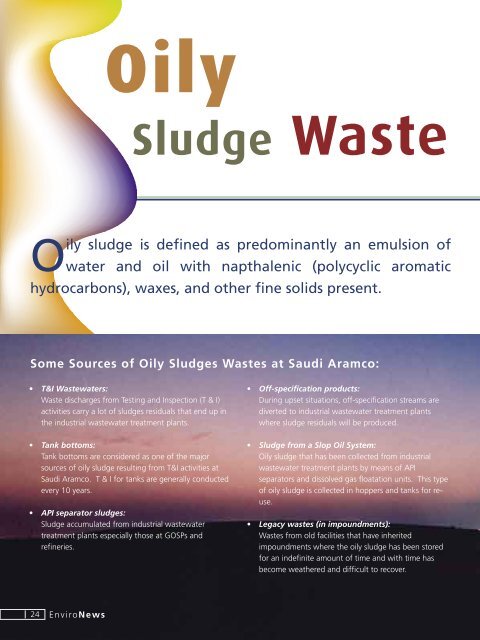Oily Sludge Waste - Saudi Aramco
Oily Sludge Waste - Saudi Aramco
Oily Sludge Waste - Saudi Aramco
Create successful ePaper yourself
Turn your PDF publications into a flip-book with our unique Google optimized e-Paper software.
<strong>Oily</strong><strong>Sludge</strong> <strong>Waste</strong><strong>Oily</strong> sludge is defined as predominantly an emulsion ofwater and oil with napthalenic (polycyclic aromatichydrocarbons), waxes, and other fine solids present.Some Sources of <strong>Oily</strong> <strong>Sludge</strong>s <strong>Waste</strong>s at <strong>Saudi</strong> <strong>Aramco</strong>:• T&I <strong>Waste</strong>waters:<strong>Waste</strong> discharges from Testing and Inspection (T & I)activities carry a lot of sludges residuals that end up inthe industrial wastewater treatment plants.• Tank bottoms:Tank bottoms are considered as one of the majorsources of oily sludge resulting from T&I activities at<strong>Saudi</strong> <strong>Aramco</strong>. T & I for tanks are generally conductedevery 10 years.• API separator sludges:<strong>Sludge</strong> accumulated from industrial wastewatertreatment plants especially those at GOSPs andrefineries.• Off-specification products:During upset situations, off-specification streams arediverted to industrial wastewater treatment plantswhere sludge residuals will be produced.• <strong>Sludge</strong> from a Slop Oil System:<strong>Oily</strong> sludge that has been collected from industrialwastewater treatment plants by means of APIseparators and dissolved gas floatation units. This typeof oily sludge is collected in hoppers and tanks for reuse.• Legacy wastes (in impoundments):<strong>Waste</strong>s from old facilities that have inheritedimpoundments where the oily sludge has been storedfor an indefinite amount of time and with time hasbecome weathered and difficult to recover.24 EnviroNews
The main impact of oily sludge on the environment is thepotential for groundwater contamination if the oily sludgeis left untreated and exposed to the ground especially if thegroundwater level is shallow (less than 30 meters) Also, oilysludge waste left in the vicinity of the marine environmentcan contaminate the coastal waters.In the past, oily sludge has been either landfilled orincinerated. However, the difficulty of finding suitablelandfill sites, the risk of groundwater contamination, andthe high cost of incineration have combined to reduce theacceptability of either of these methods for the disposal ofoily sludge.Current <strong>Saudi</strong> <strong>Aramco</strong> regulations state that waste oils/water, hydrocarbons/water mixtures, and emulsions areclassified as hazardous waste.The <strong>Saudi</strong> <strong>Aramco</strong> General Instruction GI 430.001 “<strong>Waste</strong>Management” governs all types of waste including oilysludge. This GI states that oily sludges shall be disposedof immediately after generation. If logistics prevent theimmediate transport to disposal facilities, storage is allowedfor a maximum of 90 days. Therefore, it is important thatsuch waste is properly treated and disposed of in a timelymanner.Additionally, the recently introduced government GeneralEnvironmental Regulations (GER) require all hazardouswaste management facilities that store such waste for morethan three (3) months to be subject to numerous stringentinspections and monitoring & reporting requirements.EPD has investigated many different methods and proceduresfor the proper management of oily sludge wastes andcontinues to look at new technologies. Some of thesemethods, procedures, and technologies include:1. Source reduction techniques that involve the use of intankmixers, tank-cleaning methods, good housekeepingpractices, and waste segregation procedures.2. Recycling of oily wastes using physical phase separationtechniques such as centrifugation, use as feedstock inthe manufacture of waterproofing and constructionmaterials, in road construction, and as a fuel in cementkilns.3. Thermal desorption techniques for the recovery of thevolatile hydrocarbons.4. Treatment (with no recovery of hydrocarbon value) usinglandfarming techniques, bioreactors, and incineration.EnviroNews25
5. Disposal (with no recovery of hydrocarbon value) usinglined impoundments (pits and ponds)EPD’s continuing efforts to minimize the generation of oilysludge waste include the following activities:This system is helping EPD and the facilities to develop betterstrategies for waste management and economical recyclingopportunities.Environmental Performance Assessment (EPA)<strong>Oily</strong> Pits SurveysEPD conducts site surveys at industrial facilities to determinethe presence of oily pits versus what has been reported.<strong>Waste</strong> Minimization OpportunitiesThis activity is conducted as per SAEP-1661 on all newfacilities and facilities that have undergone a major expansion.An EPD team conducts a detailed survey of the facility todetermine how to best minimize the waste generated, andhow to recycle or recover value from as much of the wasteas possible.<strong>Waste</strong> ManifestingManifesting of solid and hazardous waste streams is arequirement as per Section 6 of the GI 430.001. In the past,operating facilities and their waste handling contractors hadto do the manifesting manually using a multi-part “<strong>Waste</strong>Manifest” form. As of May 1, 2006, however, the manualsystem has been replaced with the online SAP EH&S system.This is an environmental audit program that EPD conducts atall <strong>Saudi</strong> <strong>Aramco</strong> industrial facilities. Environmental concernsthat include the discharges of waste including oily sludgefrom a facility are documented and reported. Facilities arealerted of any improper discharge or storage of oily sludgeduring the inspection visit and given EPA finding. Each EPAfinding is tracked and kept open until the facility properlyaddresses the problem. Facilities that do not close their EPAfindings in a timely manner can be penalized by receiving alower Facility Environmental Performance (FEP) score. Thescore determines the overall environmental performanceranking of the facility among other Company facilities.Submitted by: Tamim A. Al-Buraikan & Thamer S. Mutairi, EPD26 EnviroNews
















